
At that time another powerful conqueror, Amir Timur, the founder of the empire comprising practically the entire Central Asia and Persia, gained strength. The Golden Horde was on his way: until there was the caravan route from China to Europe via the Crimea, the Bottom Volga region and Khoresm, he could not count on economic prosperity of his main domain. Timur fulfilled his ambition by taking Astrakhan and Serai Berk by storm. Looting and utter annihilation of those cities froze the trade. The Golden Horde found itself isolated and withered; and after the last disastrous Moscow campaign it went rack and ruin.
With the destruction of Serai Berke and defeating the Golden Horde the northern route linking the Middle and Far East was liquidated and the entire caravan trade was transferred to the south. Caravans from China to the Middle East again headed via Otrar, Tashkent, Samarkand, Balkh, and Herat. The whole stream of goods rushed on the roads passing via Transoxiana. The order on the routes was restored and merchants could travel without fear carrying fabrics, glasses, metal products. From India there was the road via Hindu Kush and Balkh. From Kipchak lands across the Syr-Darya they carried furs, leather products, canvas. The caravan route from the East, from the river of Hwang Ho moved caravans from China with the most expensive of goods - silks, jewels, agates and pearls, medicines and porcelain.
The customs duties and taxes were raised in all caravan cities and stops. In case the goods were plundered on territory of his empire, the entire province had to compensate the losses in double, and pay Timur five times as much.
All caravan trade routes joined in Samarkand, the Empire’s capital. The city became the crossroads of Asia, the continent’s center. According to Timur's plan, Samarkand was to adequately represent his powerful empire and become the most beautiful city in the world. In terms of luxury it was supposed to surpass everything the human imagination was capable of so that the descendants were aware of the might and power of his empire.
Across the deserts and mountain passes the transports laden with everything which could be used to decorate Samarkand hastened to reach the city. From India there went caravans of elephants with treasures from ruined and plundered temples and palaces of Punjab and Delhi Sultanate. From Damascus and Bagdad, from Anatolia and Ormuzd, from the banks of the Volga and the Caucasus day and night moved the carts transporting building materials and works of art from the ruins of rebellious cities.
Around Samarkand there were founded small settlements bearing the names of large cities of the world - Bagdad, Damascus, Cairo, Shiraz, Sultania and even Paris later renamed into Farish.
In the end of the 14th century Timur started to prepare for the conquest of the eastern part of the Silk Road, China and Indochina, but he was too late. His heirs divided his empire among themselves; it did not revive any more. Uzbek khan, Sheybani using diplomacy and power gradually took in hand the lands of Transoxiana. The economies of the cities were gradually restored. In the 16th century crafts and trade in the cities of Bukhara, Samarkand and Tashkent was well-developed. The domed buildings, caravanserais, mosques and other structures erected under Abdulla Khan have survived in Bukhara.
With crafts development trade also prospered. In the 16th century Bukhara and Khiva embassies together with trade caravans went to Moscow, India, Iran, Kashgar, Siberia, and Kazakh steppes. In return their embassies arrived in Bukhara. After Kazan and then Astrakhan khanates were annexed to Moscow state in 1557 merchants from Khoresm appeared there, and Moscow merchants came to Bukhara.
In 1558 Bukhara was visited by Jenkinson, an Englishman, who was the official ambassador of Ivan the Terrible. In 1559 he was joined by the embassies from Bukhara, Balkh and Urgench on his trip back to Moscow for the purpose of conclusion trade agreements. Later on Abdulla Khan repeatedly sent his ambassadors to Ivan the Terrible and his son.
Moscow imported “the fish teeth” (walrus tusks), furs, skins, honey, wax, wooden ware, metal products, falcons and Arctic falcons. Western Europeans brought cloth, velvet, mirrors, and weapons (although it was forbidden to export) via Moscow. The special imperial permission was mandatory to bring silver and coins to Bukhara.
Central Asia sent to Russia silk, woolen and cotton fabrics, lambskin, raw silk, carpets, spices, dried fruit and so forth. Central Asia was known for trading slaves, mainly Iranians captured by Uzbeks during their raids to Khurasan, and Russians whom they bought from the nomads of Dashti-Kipchak.

